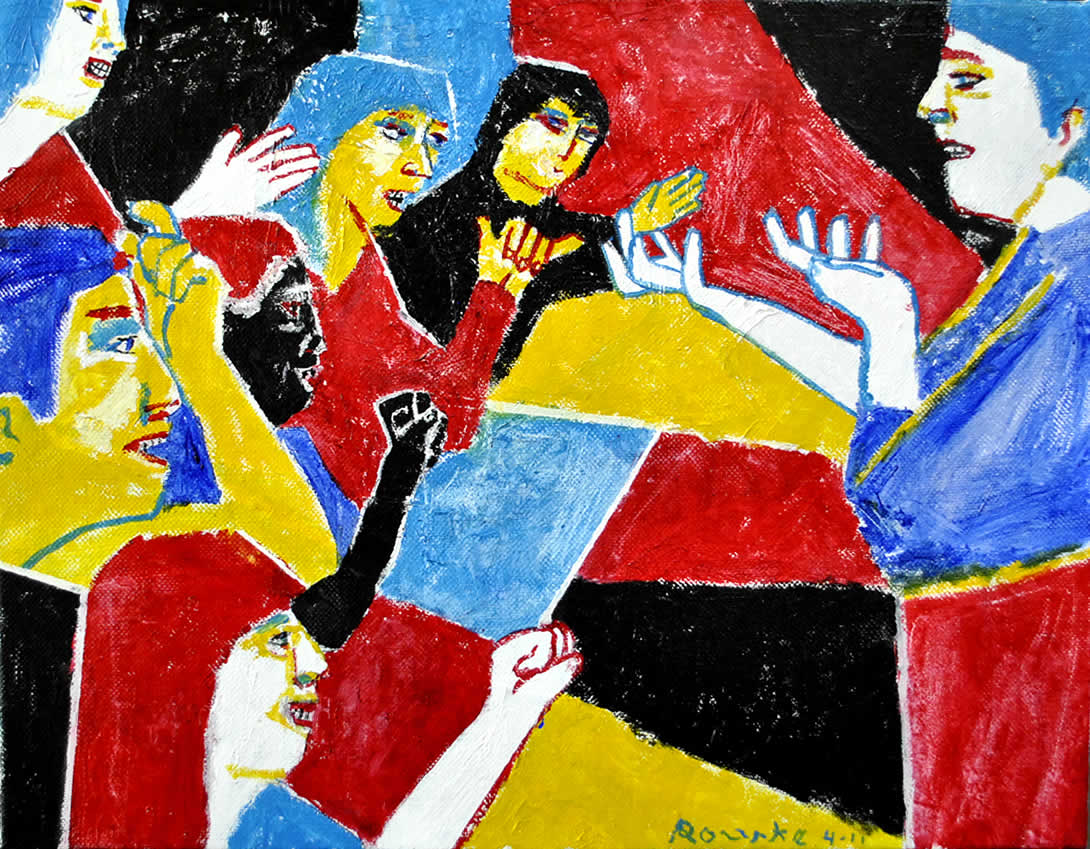Still from ASCII animation "The Death of Natural Language" by Clint Enns (link to gallery).
What is language death? What different pathways to extinction does Grinevald suggest? Which effects does language deterioration have on language structure?
For the purposes of this dissertation a language is considered "dead" when there are no fluent or partially fluent speakers left and the language is not used anymore for any purposes. The following section considers the concepts described by Colette Grinevald Craig in the chapter "Language Contact and Language Deterioration" (Handbook of Sociolinguistics, pp 257-270) and applies them to the situation of Ulster Scots. She notes that from a linguistic perspective, Latin is not really dead but rather it has changed so much that it cannot be called Latin anymore (but Romauntsh, Italian, Spanish, Romanian etc.) Moreover "real" Latin is still used for limited purposes, esp. by the Roman Catholic church. However a lot of native american languages can be considered really dead as they are not spoken anymore by anyone for any purpose and they did not change into a different language.
Grinevald Craig distinguishes a number of different pathways to language extinction, and outlines the following:
- Sudden death – this only happens if all speakers of a language are annihilated, for instance through genocide or disease. Radical death is similar, except a few speakers are left who opt to shift to the dominant language out of self-preservation
- Gradual death, or language deterioration – the result of a “long-standing assault” on the language, which has eroded the support from the inside.
There are two different routes; typical is the “dialectal” route where the language is no longer used for formal functions and so loses its formal registers; its use becomes limited to the home and eventually is no longer transferred between generations as younger community members shift to the dominant prestige language.
The other route is what I will call the “liturgic” route, where the informal use declines but the formal functions of the language are preserved, such as use in prayers and rituals. The language may eventually die completely if the religion is not practised anymore. Grinevald Craig indicates this route as "Latinate", which may be somewhat confusing as she also uses the example of Latin to illustrate change into a different language (as described above.) Some other examples of the liturgic route would be Old Church Slavonic, Pali in Buddhist scriptures, and Kallawaya in Bolivia. That noted, the liturgic route does often go hand in hand with change into a different language rather than death, but the old language is preserved in certain contexts due to its high prestige. The insistence of some groups on using the King James bible rather than versions in modern English may give some idea of the reason why old languages would be particularly preserved in religious contexts, because the original (or in the case of the King James version of the bible, simply older) phrasing of the texts is considered sacred and unalterable.
The gradual death of a language impacts on all aspects of its structure and usage; step by step the speaker community either imports aspects of a dominant neighbouring language into their own language, or altogether shifts to the dominant language for ever more purposes. The extent and chronological order of these changes differs per situation, and commonly includes some or all of the following (here outlined briefly because of its relevance. For a full explanation I refer the reader to the chapter by Grinevald Craig.)
- Loss of registers and language forms associated with them. Most commonly this means that a language is no longer used for formal purposes such as scientific, political, or religious speech or for education (common to the dialectal route described above). The loss of a register takes with it the styles and words specific to the usage, such as specific verb tenses, or more polite sounding words. Alternatively, as in the liturgic route, a language may lose colloquial registers, taking with them informal styles of speech and only leaving for instance ritualistic phrases or prayers.
- Lexical loss. Lexical items that are easily lost include words for things that are not culturally relevant anymore and words that are so similar to those of the dominant language that they effectively merge. Relexification, or the replacement of words from the one (usually minority) language with that of the other (dominant) language, may be both a cause and an effect of lexical loss; because a non-native word is commonly substituted for a native one, the native one is gradually forgotten, thus reinforcing the need to substitute it.
- Loss in phonology. In the contact with other languages certain phonological distinctions may be lost; Grinevald Craig gives the example of contrastive vowel length in Pipil of El Salvador. The language may also gain new phonics which it did not have before e.g. a language in contact with English may start to utilise the approximant /ɹ/ as well as a rolling /r/.
- Loss in morphology. A deteriorating language may lose such grammatical aspects as appropriate gender and case or lesser-used tense settings. It could be argued that this also happened to English during its contact with French and Scandinavian, as Old English had a much more complicated system of case suffixes for nominals than any modern variant.
- Loss in syntax. A dying language may lose certain syntactic constructions in that something which was once considered correct is not anymore, or if it is still considered correct it may not used as often. This can go hand in hand with morphological loss as a reduction of cases would necessarily make the syntax more rigid to substitute for the loss of grammatical distinction.



